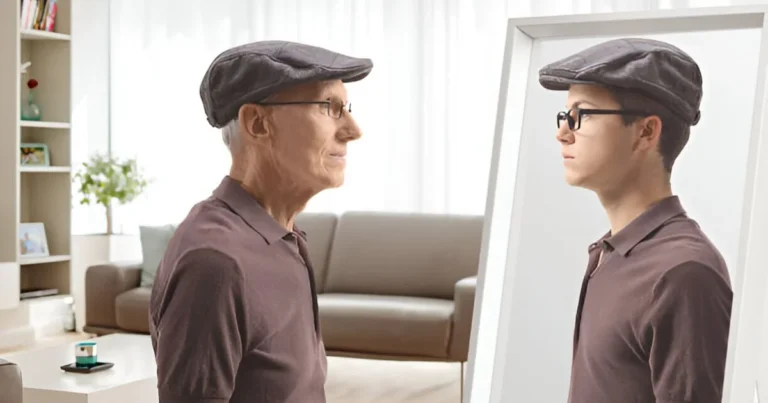The face that disappears: Inside the mind with prosopagnosia
He saw the eyes, the noses, the mouths. He could draw them with almost clinical precision, each line accurate, every curve exact. And yet, what he sketched held no meaning. He didn’t recognize what he had just drawn. Faces no longer spoke to him. They weren’t blurred, on the contrary, he saw them all too clearly, but in fragments. A chin, an ear, a pair of glasses… everything was there, scattered, disconnected, stripped of that mysterious unity that forms a face.
When shown a photograph of himself, he would shake his head. That face, he insisted, he had never seen before. Even his own reflection in a mirror remained that of a stranger. He could walk past a mirror without the faintest suspicion that the man staring back… was him. And still, he wasn’t lost in the world. He recognized objects, places, voices. What his eyes could no longer grasp, his ears would catch. He identified his wife by her voice, his friends by their laughter or the rhythm of their walk. The face alone no longer sufficed, or rather, it no longer spoke.
This isn’t fiction but a real account of a patient suffering from prosopagnosia, that strange blindness to faces, where one sees but does not recognize, where once-familiar features turn anonymous, as if erased by unfamiliarity. A form of agnosia in which the most human of landmarks suddenly becomes unreadable. In the case described by neurologist Oliver Sacks, recognition had become a kind of detour. The patient navigated a world where masks had replaced faces, where presence drifted without anchor.
The illusion of recognition: When familiarity fails
Prosopagnosia carries a dual strangeness, both clinical and existential. Faces are there, fully visible, detailed, well-lit, yet they say nothing. The eye perceives, but the person vanishes. What should spark the intimate recognition of a loved one, a parent, or a friend, triggers only an internal silence. The face becomes a nameless presence, a cluster of features as meaningless as an indecipherable signature. What’s unsettling is not a blurriness or blindness, but a chilling clarity, you see perfectly well, but no longer know who you’re looking at.
Prosopagnosia affects a very specific aspect of perception: facial recognition. Vision as a whole remains intact. Reading, identifying objects, navigating space, all these functions remain possible. What collapses is a subtle yet essential function: the ability to recognize a familiar face among many. Emotional expressions, smiles, frowns, even an intense gaze may still be perceived. But the person behind those expressions no longer emerges. The face becomes a nameless surface. The link between features and identity, once immediate, quietly unravels.
Anatomical research sheds light on this invisible loss. As early as the 1970s, scientists found that prosopagnosia is associated with lesions in the right inferior occipito-temporal region, sometimes symmetrically affecting the fusiform gyri. These areas, situated at the interface between visual perception and identity memory, form a neural map of the human face. When damaged, even partially, the brain loses its ability to read a face as a whole. All that remains are fragments, incoherent pieces. Some patients can describe glasses, a nose, a scar… but are unable to say who these features belong to.
And yet, the face is our most essential mirror. It is through it that we connect, feel familiarity, and recognize someone as someone. In prosopagnosia, this primary function is abolished. The world becomes a crowd of familiar strangers, a procession of masks where one must always guess, assume, or pretend to know. For some, this loss feels like a quiet social exile, a daily inconvenience, sometimes a deep personal sorrow. Not recognizing your own reflection, failing to identify your child without hearing their voice, is to be cut off from a part of oneself as well as from others.
Still, these patients are neither delusional, demented, nor blind. They have simply lost access to what we take for granted: the presence of others within their faces. They remind us that the seemingly mundane act of recognizing a face is, in fact, a neurological miracle, a fragile balance between perception, memory, emotion, and attention.
The brain’s broken map: Unraveling the face network
Facial recognition is such a fundamental skill that it seems effortless. Within hours of birth, infants turn instinctively toward faces. In adulthood, it becomes an automatic, rapid, often unconscious process. However, for some, this mechanism never fully develops. In developmental prosopagnosia, the difficulty in recognizing faces is not acquired over time or caused by injury; it’s present from early childhood, rooted in atypical specialization of the brain circuits involved in facial recognition. A way of being in the world without ever capturing that invisible presence that makes each face unique.
Long overlooked, this condition affects approximately 2 to 3 percent of the population and often goes undiagnosed. Those affected develop compensatory strategies early on: recognizing others by their voice, gait, scent, or even the objects they carry. It’s a peripheral, indirect form of recognition, sometimes effective, always fragile. In 2023, an international research team, Valerio Manippa, Annalisa Palmisano, Martina Ventura, and Davide Rivolta, published a significant study in the journal Brain Sciences. Their goal was to understand, after twenty-five years of neuroimaging studies, what truly happens in the brains of individuals with developmental prosopagnosia. Rather than a mere summary of existing findings, their work connects the dots across multiple studies, shedding light on the disorder through the lens of current knowledge, a way to trace the underlying thread of a long-misunderstood condition.
What their research reveals is that facial recognition doesn’t rely on a single brain area, but on a complex network, primarily in the right hemisphere. This “core face network” includes three key regions: the occipital face area (OFA), which detects facial features; the fusiform face area (FFA), which helps identify faces; and the posterior superior temporal sulcus (pSTS), which tracks movements such as expressions and gaze. This core is supported by a broader network responsible for recognizing emotions, accessing person-related memories, and maintaining attention to familiar faces.
In developmental prosopagnosia, this system doesn’t operate as it should. The researchers analyzed 63 studies involving more than 800 individuals with the disorder to better understand its origins. While earlier investigations failed to pinpoint clear abnormalities, more recent findings show reduced connectivity between brain regions, lower activity levels, and disorganized facial processing networks.
Brain scans reveal a decrease in gray matter in key areas such as the right FFA, pSTS, and middle temporal gyrus. Although the latter isn’t specifically dedicated to faces, it plays a role in retrieving information about known individuals, such as their name or background. Additionally, the connections between these areas, particularly in the right hemisphere, are less efficient. It’s as if the brain’s highways between visual regions and facial recognition hubs are partially blocked.
The dysfunction goes beyond anatomy. The activity within these regions is also disrupted. In a typical brain, the FFA reduces its activity when the same face is shown repeatedly, a sign of recognition. In prosopagnosia, this reduction doesn’t occur. The brain seems to react to each face as if it were brand new, unable to anchor it in memory. More surprisingly, some individuals can perceive facial features and even identify emotions or expressions, yet still fail to recognize who the person is. This suggests the problem lies not in vision itself, but in the transition from perception to memory, as if the face remains forever unfamiliar, no matter how many times it is seen.
Electroencephalography (EEG) recordings support this idea. A specific wave, known as N170, typically appears about 170 milliseconds after seeing a face. It’s stronger for faces than for objects, and more pronounced in the right hemisphere. In individuals with prosopagnosia, this wave is often weaker, less specific, or poorly lateralized. Other brainwaves associated with memory and conscious recognition are also disrupted. It’s as though the brain begins the recognition process… but doesn’t finish it.
Nevertheless, the condition manifests differently from one person to another. Some develop ingenious strategies: recognizing people by their voice, gait, clothing, or scent. Others show nearly normal brain responses yet still cannot recognize faces. This underscores that developmental prosopagnosia is a spectrum rather than a singular category.
There is hope, however. Recent research suggests that the brain can adapt. A study led by DeGutis and colleagues tested a training program based on holistic face perception, the ability to see a face as a whole rather than as a sum of parts. After this training, participants showed improvements both in performance and in brain activity, particularly in key areas such as the FFA and OFA. This indicates that even atypical neural circuits can be stimulated and strengthened with the right methods.
The neurologist who couldn’t see faces
Prosopagnosia isn’t just a subject of clinical study, it can also affect those doing the studying. Renowned neurologist Oliver Sacks knew this firsthand. For a long time, he didn’t realize that his struggles with face recognition had a name. He thought he was simply absent-minded, or eccentric, as he liked to say with humor. It wasn’t until he met patients with prosopagnosia that he recognized in their experience a reflection of his own.
Sacks didn’t forget people. He remembered their words, their energy, even the music of their voice. But their faces never registered. He could ride an elevator with a colleague and speak to them as if they were a stranger. He might warmly greet a friend… only to fail to recognize them an hour later if they had changed jackets. He once explained that he could feel lost in a crowded room because no face stood out, each one blurred into a sea of interchangeable silhouettes. He also recounted, with a mix of humor and melancholy, how he couldn’t recognize himself in a mirror or photo unless an external clue, his beard, his suit, the background, betrayed his identity. It wasn’t memory loss. It was an inability to match the face seen with the self known.
This revelation marked a turning point. What he had considered an odd personal quirk became a recognized neurological condition. By becoming the subject of his own case study, Sacks illustrated more poignantly than anyone how prosopagnosia is not a matter of inattention or social detachment, but a profound variation in how the brain links image to meaning. Living with the disorder, he said, meant navigating a world of relationships without faces, learning to listen more closely, to notice tiny details, to cultivate alternative forms of recognition. Still, it could sometimes feel disorienting at the heart of an encounter, as if the other person were present, but shrouded in a blur no clarity could dispel.
By revealing his own prosopagnosia, Oliver Sacks humanized the condition he wrote about. He turned this perceptual gap into a window onto the mysteries of the brain, and the invisible role it plays in our social bonds. He showed that one can be a brilliant neurologist… without ever recognizing the face of a colleague in the hallway.
A world without faces is not an empty one, it is simply rearranged. It becomes a world of voices, silhouettes, and gestures. A world where identification follows different paths. And within that world, people with prosopagnosia are neither lost nor broken. They experience it differently. They see differently. Their condition invites us to rethink perception not as the passive reception of stimuli, but as the art of weaving meaning from fragments.
References
Manippa, V., Palmisano, A., Ventura, M., & Rivolta, D. (2023). The neural correlates of developmental prosopagnosia: Twenty-five years on. Brain Sciences, 13(10), 1399.
Meadows, J. C. (1974). The anatomical basis of prosopagnosia. Journal of Neurology, Neurosurgery, and Psychiatry, 37(5), 489–501. https://doi.org/10.1136/jnnp.37.5.489
Lahiri, D. (2020). Prosopagnosia. Cortex. Advance online publication.
Sacks, O. (2010). L’œil de l’esprit (trad. F. Rosso). Paris : Seuil.

Sara Lakehayli
PhD, Clinical Neuroscience & Mental Health
Associate member of the Laboratory for Nervous System Diseases, Neurosensory Disorders, and Disability, Faculty of Medicine and Pharmacy of Casablanca
Professor, Higher School of Psychology







